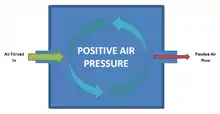Positive pressure
Positive pressure is a pressure within a system that is greater than the environment that surrounds that system. Consequently, if there is any leak from the positively pressured system it will egress into the surrounding environment. This is in contrast to a negative pressure room, where air is sucked in.[1][2]

Use is also made of positive pressure to ensure there is no ingress of the environment into a supposed closed system. A typical example of the use of positive pressure is the location of a habitat in an area where there may exist flammable gases such as found on an oil platform or laboratory cleanroom. This kind of positive pressure is also used on operating theaters and in vitro fertilisation (IVF) labs.
Hospitals may have positive pressure rooms for patients with compromised immune systems. Air will flow out of the room instead of in, so that any airborne microorganisms (e.g., bacteria) that may infect the patient are kept away.[2]
This process is important in human and chick development. Positive pressure, created by the closure of anterior and posterior neuropores of the neural tube during neurulation, is a requirement of brain development.
Amphibians use this process to respire, whereby they use positive pressure to inflate their lungs.
Historic Utility
Industrial Utility
Industrial use of positive pressure systems are commonly used to ventilate confined space with dust, fumes, pollutants and/or high temperatures [3]
Clinical Utility
Many hospitals are equipped with negative and positive pressure rooms just for the purposes described. Negative pressure rooms are used to help keep airborne pathogens (eg. aerosolized COVID-19 and active TB). Positive pressure rooms are used for immunocompromised persons (eg. Neutropenic).[4]
See also
References
- Angstrom-Tech-Admin (2016-04-20). "What's the Difference Between Positive and Negative Air Pressure Cleanrooms?". Angstrom Technology. Retrieved 2020-05-01.
- "Negative and Positive Pressure Rooms 101 | Hospital Infection Control". Air Innovations. 2019-04-29. Retrieved 2020-05-02.
- Positive pressure technology for construction and industrial ventilation applications.
https://www.southern-tool.com/store/cms//142/b32e0_184-item.pdf
- Rosenbaum, Robert A.; Benyo, Jeffrey S.; O'Connor, Robert E.; Passarello, Brent A.; Williams, Daniel R.; Humphrey, Brian D.; Ross, Robert W.; Berry, James M.; Krebs, Jeffrey G. (December 2004). "Use of a portable forced air system to convert existing hospital space into a mass casualty isolation area". Annals of Emergency Medicine. 44 (6): 628–634. doi:10.1016/j.annemergmed.2004.03.012. ISSN 1097-6760. PMC 7118873. PMID 15573039.